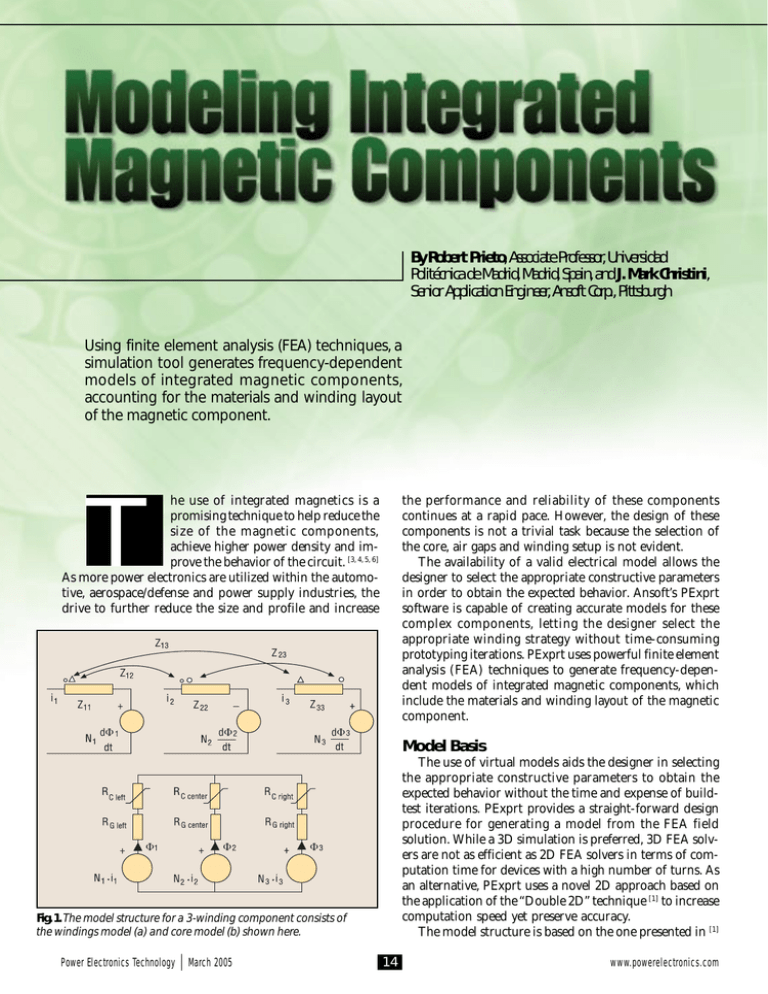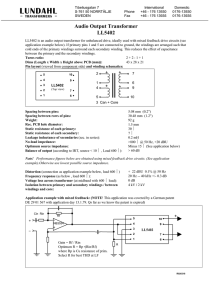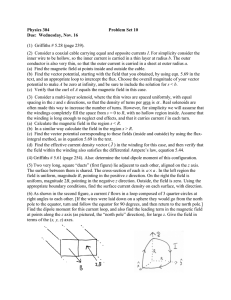Using finite element analysis (FEA) techniques
advertisement

By Robert Prieto, Associate Professor, Universidad Politécnica de Madrid, Madrid, Spain, and J. Mark Christini, Senior Application Engineer, Ansoft Corp., Pittsburgh Using finite element analysis (FEA) techniques, a simulation tool generates frequency-dependent models of integrated magnetic components, accounting for the materials and winding layout of the magnetic component. he use of integrated magnetics is a promising technique to help reduce the size of the magnetic components, achieve higher power density and improve the behavior of the circuit. [3, 4, 5, 6] As more power electronics are utilized within the automotive, aerospace/defense and power supply industries, the drive to further reduce the size and profile and increase the performance and reliability of these components continues at a rapid pace. However, the design of these components is not a trivial task because the selection of the core, air gaps and winding setup is not evident. The availability of a valid electrical model allows the designer to select the appropriate constructive parameters in order to obtain the expected behavior. Ansoft’s PExprt software is capable of creating accurate models for these complex components, letting the designer select the appropriate winding strategy without time-consuming prototyping iterations. PExprt uses powerful finite element analysis (FEA) techniques to generate frequency-dependent models of integrated magnetic components, which include the materials and winding layout of the magnetic component. T d⌽ d⌽ d⌽ Model Basis The use of virtual models aids the designer in selecting the appropriate constructive parameters to obtain the expected behavior without the time and expense of buildtest iterations. PExprt provides a straight-forward design procedure for generating a model from the FEA field solution. While a 3D simulation is preferred, 3D FEA solvers are not as efficient as 2D FEA solvers in terms of computation time for devices with a high number of turns. As an alternative, PExprt uses a novel 2D approach based on the application of the “Double 2D” technique [1] to increase computation speed yet preserve accuracy. The model structure is based on the one presented in [1] (a) ⌽ ⌽ ⌽ (b) Fig. 1. The model structure for a 3-winding component consists of the windings model (a) and core model (b) shown here. Power Electronics Technology March 2005 14 www.powerelectronics.com Intelligent MAGNETIC COMPONENTS MotionControl Enlarged View: 4x Size: 6mm2 Fig. 2. The “Double 2D” procedure application depicts the 3D structure and the associated 2D simulations. the MC73110 Brushless MotorControllerIC • Ultra high-performance • Low cost • Sinusoidal or 6-step commutation • Internal profile generation • High-speed index capture • 6 signal PWM with shoot through protection • Digital current loop • Velocity loop The Best Engineered Products in Motion Fig. 3. An EI core shape and size is selected from the PExprt library. PERFORMANCEMOTIONDEVICES MOTORDRIVES AMPLIFIERS CONTROLLERS © 2004 Performance Motion Devices, Inc. www.pmdcorp.com and [7]. The structure of the model is shown in Fig. 1 for a 3-winding component (assuming one winding in each core leg). There is an electric submodel (top) coupled with a magnetic submodel (bottom). In Fig. 1, the impedance Z11 represents the windings impedance (magnetic energy and power losses) when the net current is only flowing though winding 1. Therefore, the impedance Z11 is not the self-impedance of winding 1, because losses and energy at the whole component (except the core area) are considered in this impedance value. The meaning of impedances Z22 and Z33 is equivalent to the one of impedance Z 11 when net current flows through windings 2 and 3, respectively. Z12 represents the windings impedance (magnetic energy and power losses) factor due to the simultaneous conduction of net current through winding 1 and winding 2. In other words, the energy and the losses in the windings when the current is flowing simultaneously through windings CIRCLE 213 on Reader Service Card or freeproductinfo.net/pet Power Electronics Technology March 2005 16 www.powerelectronics.com MAGNETIC COMPONENTS Fig. 4. After winding setups are defined, a cross-sectional view of the component is created by PExprt. are considered. The model also is frequency dependent and is valid for nonsinusoidal waveforms. Another benefit is that the couplings between each pair of windings are accurately calculated. Speed is another advantage. The solution time is fast—the average time for common components is less than 15 min. Furthermore, the model generation is completely implemented in PExprt, so the user does not need to learn how to use the FEA solver. PExprt creates the FEA project automatically and solves the fields. Generating the Model Fig. 5. A menu in PExprt enables users to define the pc-board conductors. 1 and 2 (transformer mode) are not the addition of the ones obtained when current is flowing through winding 1 and winding 2 alternatively (inductor mode). This effect is taken into consideration by Z12. The rest of the impedances, Zij, are analogous to Z12, describing the windings impedance due to simultaneous conduction of net current through the other pairs of windings. The core part of the magnetic component is represented by a set of reluctances and mmf sources. There is a reluctance for each core column (ÂC) and another for each gap (ÂG). It is possible to replace the core reluctance with a nonlinear core model (such as the Jiles-Atherton model) to represent hysteresis and eddy current losses. The simulation procedure proposed in this work is based on the “Double 2D” approach presented in [2]. Power Electronics Technology March 2005 This approach is based on the division of the windings of the magnetic component in two parts. Each part produces field distribution in different planes of the space. In this way, it is possible to use 2D FEA solvers to study these structures. Fig. 2 shows the actual 3D structure and the double 2D simulations needed to simulate it. The double 2D process requires simulation of four 2D structures. However, the simulations that account for the field distribution in the air for each leg (side views) are very simple. Therefore, the solution time for these three cases is extremely short. The FEA model offers several advantages. Because it is based on FEA calculations, it is accurate (error below 10% for most of the application range) and 2D effects (such as the fringing flux effect around the air gap) 18 Defining the core shape, size and material. The selection of the core shape and size is simple. PExprt provides libraries containing most of the commercially available cores. The appropriate core shape for an integrated structure can be directly selected from the library. An EI shape is selected for this example, as shown in Fig. 3. Defining the winding setup. Once the core is selected, the winding setup for each core leg should be defined. PExprt provides a flexible user interface that allows the user defining any winding connection. The turns can be connected either in parallel or series, creating any possible interleaving structures. A different winding strategy can be defined and assigned for each core leg. Once the winding setups are created and assigned to each core leg, a cross-section view of the component can be visualized, as shown in Fig. 4. For this device all windings are on the outer core legs only. Defining the pc-board conductors. The thickness and width of each planar track can be defined easily to obtain the real behavior (resistance, coupling, leakage and magnetizing inductances, and capacitive effects) of the component. The pc-board conductors are defined through easy-to-use menus such as that shown in Fig. 5. Exploring the Results PExprt contains a model generation engine that connects the FEA www.powerelectronics.com MAGNETIC COMPONENTS solver with the equivalent circuit model. Once the model is obtained, it can be exported to a circuit simulator (Simplorer, PSpice) or it can be used in PExprt to explore the small-signal behavior of the component. The resistance and leakage inductance as a function of frequency can be plotted using the tool. The dc resistance, magnetizing inductance and parasitic capacitive effects also can be obtained. Fig. 6 shows the resistance as a function of the frequency. Once the integrated magnetic model is generated with PExprt Modeler, you can use that circuit model in Simplorer to explore the performance of your entire circuit. The resulting schematic is represented in Fig. 7. Validating Results To demonstrate how to use PExprt, we model a push-pull forward converter with integrated magnetics for a voltage regulator module (VRM) that produces a 1.2-V, 70-A output from a 48-V input. Fig. 6. The tool can plot parameters such as resistance versus frequency. More power to you. Custom SMPS Magnetics For standard parts “tailored” to your application or a custom device for your specific requirement, contact an ICE engineer today to quickly realize your design goals. • Innovative Designs • Award-Winning Customer Service • Low Cost • Fast Turn-Around Helping Engineer the Technology of Power w w w. i c e c o m p o n e n t s . c o m • ( 8 0 0 ) 7 2 9 - 2 0 9 9 • ISO 9001/9002 CIRCLE 216 on Reader Service Card or freeproductinfo.net/pet Power Electronics Technology March 2005 CIRCLE 217 on Reader Service Card or freeproductinfo.net/pet 20 www.powerelectronics.com MAGNETIC COMPONENTS leg and no air gap in the two outer legs. Fig. 8 shows the topology selected for this example. The validity of the integrated magnetics component model was confirmed in the lab where the measured results for the device closely matched those simulated by PExprt.” PETech References 1. Asensi, R.; Cobos, J.A.; Garcia, O.; Prieto, R.; and Uceda, J. “A Full Procedure to Model High Frequency Transformer Windings.” Fig. 7. A circuit model of the magnetic component generated in PExprt Modeler can be ported in Simplorer for Power Electronics Specialist simulation of the entire circuit. Conference (PESC) 1994. 2. Prieto, R.; Cobos, J.A.; Garcia, O.; Alou, P.; and Uceda, J. SR2 _ a c “Model of Integrated Magnetics by Means of ‘Double 2D’ Finite Element a p Q2 Analysis Techniques.” Power ElectronVo Co ics Specialist Conference (PESC) 1994. p d Vin 3. Xu, P; Ye, M; Wong, P; Lee, F.C. “De+ q + sign of 48-V Voltage Regulator Modules q Cs with a Novel Integrated Magnetics.” SR1 b Power Electronics IEEE Transactions, e b Vol. 17, No. 6 (November 2002), pp. Q1 990-998. 4. Wei, J.; Xu, P.; Lee, F.C. “A High EffiSR2 ciency Topology for 12-V VRM-Pushc a n:n:1 Pull Buck and Its Integrated Magnetics Q1 p Implementations.” Applied Power Elecq Vo Lo2 Co tronics Conference and Exposition b 2002. Seventeenth Annual IEEE, Vol. 2, + + Vin n:n:1 2002, pp. 679-685. d 5. Xu, P. and Lee, F.C. “Design of HighCs b Input Voltage Regulator Modules with Lo1 q a Novel Integrated Magnetics.” Applied SR1 p Power Electronics Conference and ExQ1 a position 2001. Sixteenth Annual IEEE, e Vol.1, 2001, pp. 262-267. 6. Chen, W.; Hua, G.; Sable, D.; Lee, F. Fig. 8. The design example consists of a push-pull converter with integrated magnetics. Shown “Design of High-Efficiency, Low-Profile, here are the actual implementation (a) and the equivalent electrical circuit (b). Low-voltage Converter with Integrated Magnetics.” Applied Power Electronics The example is based on the paper, The transformer windings (primary Conference and Exposition, 1997. 12th “Design of 48-V Voltage Regulator 1 and primary 2) as well as the inducAnnual, Vol. 2, Feb. 23-27, 1997, pp. Modules with a Novel Integrated tor winding (secondary) are wound 911-917. Magnetics.” [3] In this structure, all the on the two outer legs. The interleav7. Prieto, R; Asensi, R; Cobos, J; and magnetic components, including ining winding technique is used to Uceda, J. “A Full Procedure to Model put filter inductor, step-down transminimize the leakage inductance of Integrated Magnetics based on FEA.” former and output filter inductors, are the integrated transformer. The core APEC 2004 Conference Proceedings. integrated into a single EI or EE core. structure has an air gap in the center Power Electronics Technology March 2005 22 www.powerelectronics.com



